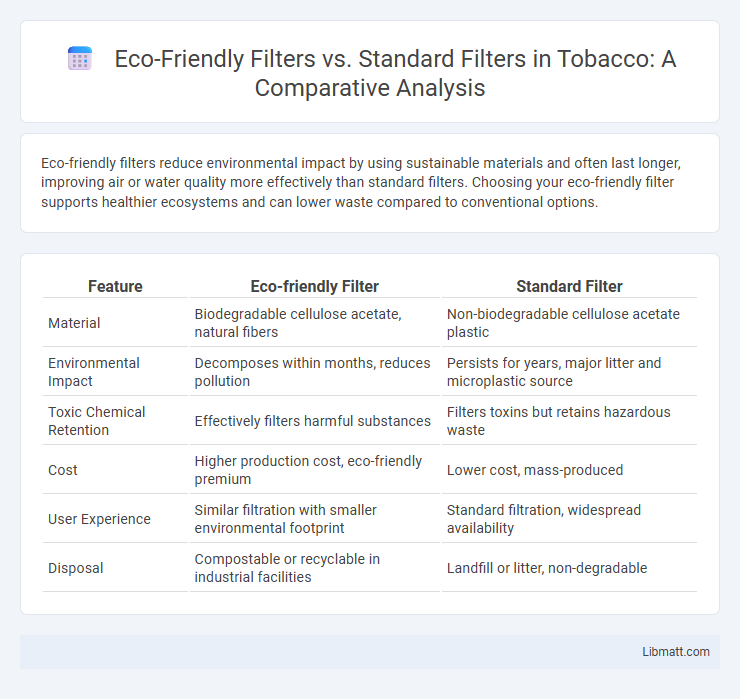Eco-friendly filters reduce environmental impact by using sustainable materials and often last longer, improving air or water quality more effectively than standard filters. Choosing your eco-friendly filter supports healthier ecosystems and can lower waste compared to conventional options.
Table of Comparison
| Feature | Eco-friendly Filter | Standard Filter |
|---|---|---|
| Material | Biodegradable cellulose acetate, natural fibers | Non-biodegradable cellulose acetate plastic |
| Environmental Impact | Decomposes within months, reduces pollution | Persists for years, major litter and microplastic source |
| Toxic Chemical Retention | Effectively filters harmful substances | Filters toxins but retains hazardous waste |
| Cost | Higher production cost, eco-friendly premium | Lower cost, mass-produced |
| User Experience | Similar filtration with smaller environmental footprint | Standard filtration, widespread availability |
| Disposal | Compostable or recyclable in industrial facilities | Landfill or litter, non-degradable |
Introduction to Air Filtration Technologies
Eco-friendly filters utilize sustainable materials and advanced filtration media designed to capture airborne particles while minimizing environmental impact, unlike standard filters that often rely on synthetic fibers and less biodegradable components. These innovative air filtration technologies combine high efficiency in trapping dust, allergens, and pollutants with reduced carbon footprint and improved recyclability. By integrating eco-friendly filters into HVAC systems, indoor air quality enhancement aligns with green building practices and sustainability goals.
What Defines an Eco-Friendly Filter?
An eco-friendly filter is defined by its use of sustainable, biodegradable materials that minimize environmental impact during production and disposal. These filters often incorporate renewable resources such as organic cotton, hemp, or recycled fibers, reducing reliance on synthetic plastics common in standard filters. Unlike standard filters, which typically contribute to landfill waste and pollution, eco-friendly filters aim to reduce carbon footprint and promote healthier ecosystems through responsible manufacturing and compostable design.
Composition and Materials: Eco-Friendly vs Standard Filters
Eco-friendly filters are typically made from biodegradable materials like recycled paper, natural fibers, or plant-based plastics, reducing environmental impact. Standard filters often rely on synthetic fibers and plastic components that contribute to landfill waste and pollution. Choosing an eco-friendly filter ensures your filtration process is aligned with sustainability goals and minimizes your ecological footprint.
Energy Efficiency Comparison
Eco-friendly filters significantly enhance energy efficiency by improving airflow and reducing strain on HVAC systems, leading to lower energy consumption compared to standard filters. These filters are designed with advanced materials that trap particles without obstructing airflow, helping your system run more smoothly and cost-effectively. Your choice of an eco-friendly filter can result in measurable energy savings and a smaller environmental footprint.
Filtration Performance and Air Quality Impact
Eco-friendly filters utilize sustainable materials and advanced filtration media to effectively capture airborne particles, often matching or exceeding the filtration performance of standard filters. Their reduced environmental impact contributes to improved indoor air quality by minimizing chemical off-gassing and waste generation associated with traditional filter disposal. Choosing your filtration system with an eco-friendly filter ensures cleaner air and supports sustainable air quality management practices.
Environmental Footprint and Sustainability
Eco-friendly filters significantly reduce your environmental footprint by utilizing biodegradable materials and minimizing waste compared to standard filters made from synthetic fibers and plastics. These sustainable filters often feature reusable components, lowering resource consumption and landfill impact while promoting circular economy principles. Choosing an eco-friendly filter supports long-term ecological balance by decreasing pollution and conserving natural resources.
Cost Analysis: Upfront and Long-Term Expenses
Eco-friendly filters generally have a higher upfront cost than standard filters due to sustainable materials and advanced design. Over time, your long-term expenses may decrease as eco-friendly filters often last longer and reduce waste disposal fees. Investing in eco-friendly options supports cost savings through durability and environmental benefits.
Maintenance Requirements and Lifespan
Eco-friendly filters typically require less frequent replacements and simpler maintenance routines compared to standard filters, as they are designed with sustainable materials that resist clogging and promote longer usability. Standard filters often demand regular cleaning or early replacements due to faster degradation and accumulation of particulates. Choosing an eco-friendly filter can extend your filter lifespan while reducing the time and cost spent on maintenance.
Health and Safety Considerations
Eco-friendly filters use natural materials that reduce exposure to harmful chemicals and allergens, improving indoor air quality and protecting your respiratory health. Standard filters may contain synthetic fibers and chemical additives that can release irritants or degrade air quality over time. Choosing an eco-friendly filter promotes a safer environment by minimizing toxic emissions and supporting healthier air circulation.
Choosing the Right Filter for Your Needs
Eco-friendly filters use sustainable materials and reduce environmental impact by minimizing waste and chemical usage, making them a responsible choice for eco-conscious individuals. Standard filters, while often more affordable and widely available, may rely on synthetic components that are less biodegradable and contribute to landfill buildup. Evaluating your filtration needs, budget, and commitment to sustainability will help you decide whether an eco-friendly filter aligns better with your values and performance requirements.
Eco-friendly filter vs standard filter Infographic

 libmatt.com
libmatt.com